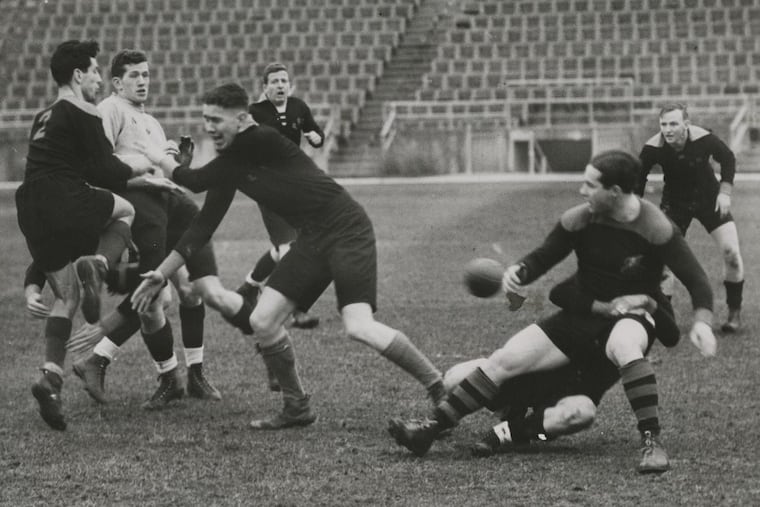Philadelphia's place in U.S. rugby history | Philly History
Today, Philadelphia and Pennsylvania are home to a number of top-notch university teams.

Many people may not consider rugby a major U.S. sport, but it has grown significantly in recent years. Today, USA Rugby — the governing body that organizes rugby competitions at all skill levels across the country — boasts 125,000 members playing in 2,673 clubs.
The sport has seen ups and downs in popularity since it was introduced in United States in the middle of the 19th century. Throughout the years, Philadelphia and the surrounding region have fielded a number of teams that shaped rugby's history.
While sports historians generally consider the 1874 faceoff between Harvard University and Montreal's McGill University as the first official rugby match in the nation's history, there is evidence that games based on the rules of rugby preceded this historical event. On Nov. 18, 1869, the Inquirer detailed a Thanksgiving Day competition between two amateur sporting associations in Philadelphia: the Germantown Cricket Club and the Young American Cricket Club. The article explains that since the "cold season has compelled them to put away the bat and ball," the two teams arranged to play a game based on rules "adopted chiefly from those of Rugby school" in England. The Germantown club came out on top.
>> READ MORE: Philly played a critical role in making rowing popular in America | Philly History
In the early decades of the 20th century, rugby rivaled football in popularity, partly resulting from the common perception of football as a particularly violent sport. In 1905, a staggering 19 football-related fatalities compelled President Theodore Roosevelt to gather representatives from Harvard, Yale, and Princeton to brainstorm ways to reform the game. During this crisis period for football, universities on the West Coast such as Stanford and the University of California at Berkeley adopted rugby as their major sport.
The West Coast's affinity for rugby created a brief golden age for the game. The United States' rugby team — represented largely by Stanford players — won Olympic gold medals in 1920 and 1924. By the 1920s, however, football had once again become the nation's dominant sport, with major schools on the West Coast switching back to football and rugby receding into the background. As football cemented its place at the top of the professional sports world, rugby primarily thrived in the collegiate realm. When the world's best national teams traveled to the United States to represent their countries, they regularly faced off against college teams. Princeton University took on a French national team in a 1937 match.
Ivy League schools served as the major torchbearers for rugby until the 1960s, when interest in the sport spread to universities across the United States. The Philadelphia area played a significant role popularizing rugby during this period. Villanova University's rugby club, among the oldest non-Ivy League teams, was founded in late 1959. The team came together thanks to the efforts of Francis Coghlan, a professor of history and a Welsh national who built the school's first rugby lineup drawing almost entirely from his own students.
>> READ MORE: Groundbreaking Philly science museum was not always beloved by city residents | Philly History
The team began competing in the Eastern Rugby Union (ERU) in 1960, facing off against storied Ivy League teams that attracted seasoned talent from around the world. While Villanova struggled early on, Coghlan's dedication as a coach and manager paid off. After placing fourth out of 16 teams in a Thanksgiving Day tournament in New York City that attracted some of the nation's best amateur clubs, Villanova won the crown of ERU's Division III and narrowly lost to Brown University, victors of Division II, in 1961. After just one year of existence, Villanova had become one of the most competitive collegiate rugby teams in the nation.
Today, Philadelphia and Pennsylvania are home to a number of top-notch university teams. St. Joseph's, Kutztown, Temple, East Stroudsburg, Drexel, and Penn State are all competing in this year's Penn Mutual Collegiate Rugby Championship.
Patrick Glennon is a communications officer at the Historical Society of Pennsylvania. pglennon@hsp.org